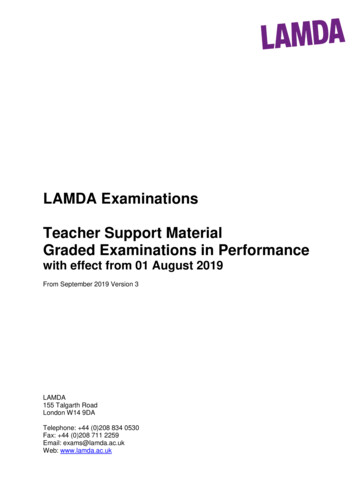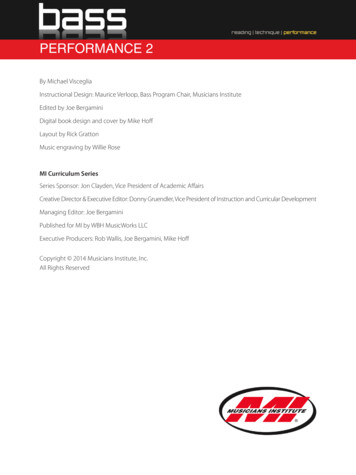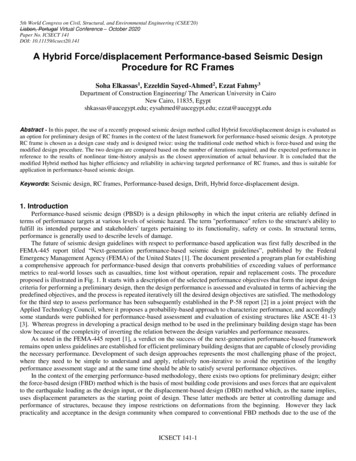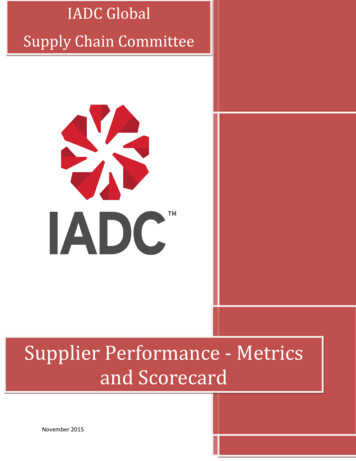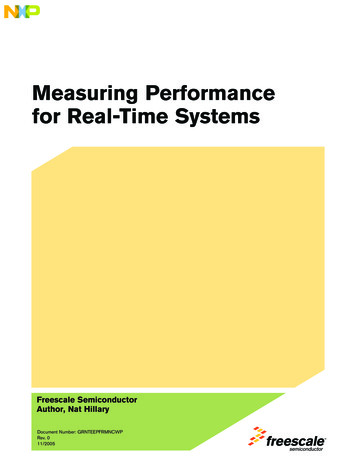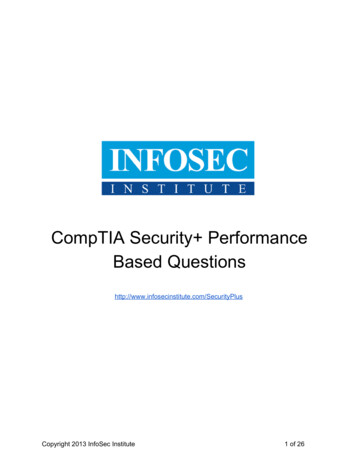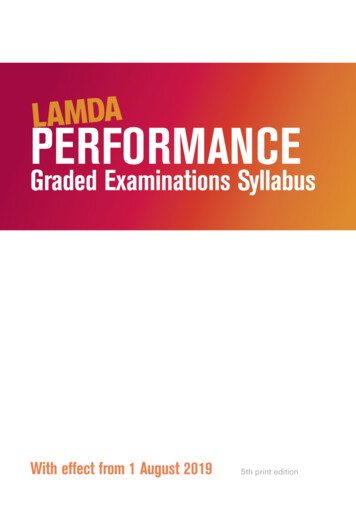
Transcription
PERFORMANCEGraded Examinations SyllabusWith effect from 1 August 20195th print edition
ContentsAbout LAMDA7LAMDA Qualifications8Qualification Framework8About This Syllabus Specification8Structure of the Qualifications8LAMDA Qualification Titles Covered in This SyllabusSpecification9Reasonable Adjustments and Special Considerations10Assessment and Grading10Assessment Requirements10Invalidation Policy11A Note on Language11Essential Resources11Support Material12LAMDA Graded Examinations in Performance: ActingChanges from the previous syllabus (September 2014)14Purpose of the Qualification20Broad Objectives of the Qualification20Structure21Examination Regulations224 Entry Level2Level Description24Learning Outcomes24Total Time Allowance25Examination Content25Marking Scheme26Assessment and Grading Criteria27
4 Level 1Level Description30Learning Outcomes31Total Time Allowance for Each Grade31Examination Content32Marking Scheme38Assessment and Grading Criteria394 Level 2Level Description44Learning Outcomes45Total Time Allowance for Each Grade45Examination Content46Marking Scheme50Assessment and Grading Criteria514 Level 3Level Description56Learning Outcomes57Total Time Allowance for Each Grade57Examination Content58Marking Scheme63Assessment and Grading Criteria64LAMDA Graded Examinations in Performance: DevisingDramaChanges from the previous syllabus (September 2014)70Purpose of the Qualification76Broad Objectives of the Qualification763
Structure77Examination Regulations784 Entry LevelLevel Description80Learning Outcomes80Total Time Allowance81Examination Content81Marking Scheme82Assessment and Grading Criteria834 Level 1Level Description86Learning Outcomes87Total Time Allowance for Each Grade87Examination Content88Marking Scheme91Assessment and Grading Criteria924 Level 24Level Description98Learning Outcomes99Total Time Allowance for Each Grade99Examination Content100Marking Scheme102Assessment and Grading Criteria103
4 Level 3Level Description108Learning Outcomes109Total Time Allowance for Each Grade109Examination Content110Marking Scheme113Assessment and Grading Criteria114LAMDA Graded Examinations in Performance: MimingChanges from the previous syllabus (September 2014)120Purpose of the Qualification124Broad Objectives of the Qualification124Structure125Examination Regulations1264 Entry LevelLevel Description128Learning Outcomes128Total Time Allowance128Examination Content129Marking Scheme130Assessment and Grading Criteria1314 Level 1Level Description134Learning Outcomes135Total Time Allowance for Each Grade135Examination Content1365
Marking Scheme139Assessment and Grading Criteria1404 Level 2Level Description146Learning Outcomes147Total Time Allowance for Each Grade147Examination Content148Marking Scheme150Assessment and Grading Criteria1514 Level 36Level Description156Learning Outcomes157Total Time Allowance for Each Grade157Examination Content158Marking Scheme162Assessment and Grading Criteria164Glossary of Terms: Syllabus Terminology170Glossary of Terms: Syllabus Content172
About LAMDAFounded in 1861, LAMDA is the oldest drama school in theUK. We started to offer examinations in speech and drama tothe public over 130 years ago. Since then we have developedan enviable reputation for excellence in the provision ofCommunication and Performance examinations in the UK, and weare rapidly extending our reach internationally.The process of preparing for and succeeding in a LAMDAExamination helps Learners, whatever their ages or aspirations, todevelop a broad range of skills that will serve them throughout life.Our examinations develop a Learner’s ability to: read easily, fluently and with good understanding expand vocabulary to improve powers of self-expression improve confidence in speaking and listening memorise and recall information research and create persuasive formal presentations create and defend arguments engage in constructive informal conversation work both on their own and participate as a member of a teamNo matter what direction Learners choose to follow in the future,our examinations provide the opportunity to nurture their naturalabilities. These critical skills will enhance their self-confidenceto engage and contribute fully, whether at school, in furthereducation, at work or in the community. In other words, to fulfiltheir potential.All our examinations are rooted in encouraging Learners of allages to develop a love of literature, poetry and drama and thusimprove standards of communication through the spoken word.This syllabus provides a wide range of opportunities to do so.Ultimately, it is a sense of achievement that empowers theLearner. We believe that succeeding in a LAMDA Examinationdemonstrates not only that they have met rigorous AssessmentCriteria in a particular discipline, but also that they have grownas individuals through participating in a worthwhile activity that isrespected as a global standard.7
LAMDA QualificationsLAMDA is recognised as an awarding organisation by Ofqual,the Office of Qualifications and Examinations Regulation inEngland, Qualifications Wales, and Council for the Curriculum,Examinations and Assessment (CCEA) in Northern Ireland.Qualification FrameworkThe LAMDA Graded Examinations in Performance reside on theRegulated Qualifications Framework (RQF). The RQF permitsdirect comparison between academic qualifications (i.e. GCSEs /A Levels) and vocational qualifications (i.e. LAMDA Qualificationsand others).About This Syllabus SpecificationThis syllabus specification outlines the specifications for LAMDAGraded Examinations in Performance. It is designed for use bycentres, Teachers, Learners and parents.Structure of the QualificationsLAMDA Graded Examinations in Performance are available in thefollowing subjects: Acting Devising Drama MimingLAMDA Graded Examinations in Performance are open toall. There are no minimum age restrictions, and the choice ofrepertoire is intended to appeal to Learners of all ages. Learnersdo not require prior knowledge or an understanding of thePerformance subjects prior to studying for a LAMDA Examination.8
The qualifications are available at four Levels on the RQF andeach examination subject is available from Entry Level to Grade 8.RQF LEVELGRADEEntry Level (E3)Entry LevelLevel 1Grade 1Grade 2Grade 3Level 2Grade 4Grade 5Level 3Grade 6Grade 7Grade 8LAMDA Qualification Titles Covered in This SyllabusSpecification603/4010/1 LAMDA Entry Level Award in Performance (Entry 3)603/4011/3 LAMDA Level 1 Award in Performance (Grade 1)603/4012/5 LAMDA Level 1 Award in Performance (Grade 2)603/4013/7 LAMDA Level 1 Award in Performance (Grade 3)603/4014/9 LAMDA Level 2 Award in Performance (Grade 4)603/4015/0 LAMDA Level 2 Award in Performance (Grade 5)603/4107/5 LAMDA Level 3 Certificate in Performance (Grade 6)603/4108/7 LAMDA Level 3 Certificate in Performance (Grade 7)603/4109/9 LAMDA Level 3 Certificate in Performance (Grade 8)The Qualification Number (QN) is a unique identifier provided byOfqual.The appropriate Qualification Title and Qualification Number(QN) will appear on Learners’ final certification documentation.9
Reasonable Adjustments and Special ConsiderationsReasonable Adjustments and Special Considerations aredesigned to facilitate access to Qualifications for Learnerswho have particular requirements. Further information can beobtained from LAMDA Examinations’ published ReasonableAdjustments and Special Considerations Policy, which isavailable to download from the LAMDA website: www.lamda.ac.uk/examinationsAssessment and GradingThe purpose of assessment is to ensure that effective learninghas taken place to give Learners the opportunity to meet all theAssessment Criteria and achieve the learning outcomes within aQualification and/or Unit.All LAMDA graded Qualifications require external assessment.External assessment is a form of independent assessment whereAssessment Criteria for each Qualification are set by LAMDA andmarked by a LAMDA Examinations Examiner.LAMDA Graded Examinations in Performance uses practicalassessment as its method for external assessment.Assessment RequirementsAll assessment for LAMDA regulated Qualifications is criterionreferenced, based on the achievement of specified LearningOutcomes and Assessment Criteria. Each Qualification and/orUnit within the Qualification has specified Assessment Criteriawhich are used for grading purposes. A Qualification grade canbe awarded at Pass, Merit or Distinction.A Pass, Merit or Distinction is awarded respectively for theachievement of all outcomes against the specified AssessmentCriteria for each grading criterion detailed in the syllabusspecification.Learners who complete the external assessment but who either donot meet the minimum pass criteria mark for a Pass or fail to satisfyone or more of the stated Assessment Criteria (irrespective of thetotal marks they accumulate) will be graded as a Fail.In these circumstances the Examiner will identify the AssessmentCriteria/Criterion not met in the Examination Report.10
Invalidation PolicyLAMDA operates an Invalidation Policy for all its Qualifications.All Learners must perform to the exact requirements as detailed inthe relevant syllabus specifications. Learners who do not conformto these requirements will be referred to LAMDA by the Examiner.The referral will be reviewed by the appropriate personnel atLAMDA who will determine whether Invalidation exists.For all confirmed Invalidation decisions, a letter detailing thereasons for the Invalidation along with the Learner’s ExaminationReport (marked Invalid) will be sent directly to the centrecoordinator or the named accountable person detailed at the timeof examination entry.A Note on LanguageEnglish is used and explicitly expressed in all LAMDA syllabusspecifications and assessment materials for the examinations.Examinations are conducted solely in English. The languageused in all syllabus specifications and assessment materials, andduring practical assessment, is explicit, plain and free from bias.Whilst LAMDA offers examinations in Ireland and Wales, it doesnot offer examinations using Welsh (Cymraeg) or Irish (Gaelige)languages.There is no requirement for Learners to conform linguistically to allfeatures of British Standard English or Received Pronunciation.However, Learners’ oral communication must be at a level thatwill not impose any difficulty of comprehension or strain on theExaminer during the assessment.Essential ResourcesThe LAMDA Acting Anthology – Volume 4 is a collection of soloand duologue scenes from published plays, novels and books orscenes which have been written specifically for this anthologyand is a required publication for Learners taking LAMDA GradedExaminations in Acting from Grade 1 to Grade 5.Details of all LAMDA publications for the examinations areavailable on the LAMDA website: www.lamda.ac.uk/examinations11
Support MaterialLAMDA has provided additional support material to aid centres,Teachers and Learners when preparing for LAMDA GradedExaminations in Performance. This document is entitled TeacherSupport Material: LAMDA Graded Examinations in Performance.It is available free of charge on the LAMDA website atwww.lamda.ac.uk/examinations or upon request from LAMDA.12
Graded Examinationsin Performance:Acting13
Changes from the PreviousSyllabus (September 2014)ENTRY LEVEL2014 Syllabus2019 SyllabusLO change:LO3: Use the performance spacein response to the textLO3: Use the face and body inresponse to the textAC separation:2.1 Speak with audibility andclarity of diction some/most/all of the time2.1 Speak with audibility2.2 Speak with clarity of dictionAC addition:3.1 Perform with movementappropriate to the charactersome/most/all of the time3.1 Perform with movement andfacial expression appropriateto the characterLEVEL 1, GRADE 12014 Syllabus2019 SyllabusAll Set Pieces have been changedand updatedAC separation:2.1 Speak with audibility andclarity of diction some/most/all of the time2.1 Speak with audibility2.2 Speak with clarity of dictionAC addition:3.1 Perform with movementappropriate to the charactersome/most/all of the time3.1 Perform with movement andfacial expression appropriateto the character and situationLEVEL 1, GRADE 22014 Syllabus2019 SyllabusAll Set Pieces have been changedand updatedAC separation:2.1 Speak with audibility andclarity of diction some/most/all of the time2.1 Speak with audibility2.2 Speak with clarity of dictionContinued on next page 414
LEVEL 1, GRADE 2 (continued)AC addition:3.1 Perform with movementappropriate to the charactersome/most/all of the time3.1 Perform with movement andfacial expression appropriateto the character and situationQuestion change: what the characters aredoing in each sceneReflected in AC 4.3 Give a brief/secure/detailed description ofwhat the characters are doing inthe chosen scenes what is happening in eachscene4.3 Give a description of whatis happening in the chosenscenesLEVEL 1, GRADE 32014 Syllabus2019 SyllabusAll Set Pieces have been changedand updatedAC separation:2.1 Speak with audibility andclarity of diction some/most/all of the time2.1 Speak with audibility2.2 Speak with clarity of dictionAC addition:3.1 Perform with movementappropriate to the charactersome/most/all of the time3.1 Perform with movement andfacial expression appropriateto the character and situationKnowledge question change: what the characters aredoing in each sceneReflected in AC 4.2 Give a brief/secure/detailed description ofwhat the characters are doing inthe chosen scenes what is happening in eachscene4.2 Give a description of whatis happening in the chosenscenesLEVEL 2, GRADE 42014 Syllabus2019 SyllabusAll Set Pieces have been changedand updatedContinued on next page 415
LEVEL 2, GRADE 4 (continued)AC wording change:1.1 Demonstrate anunderstanding of the placeand period in which thecharacters live1.1 Demonstrate anunderstanding of the situationand place in which thecha
The LAMDA Acting Anthology – Volume 4 is a collection of solo and duologue scenes from published plays, novels and books or scenes which have been written specifically for this anthology and is a required publication for Learners taking LAMDA Graded Examinations in Acting from Grade 1 to Grade 5. Details of all LAMDA publications for the examinations are available on the LAMDA website: www .
